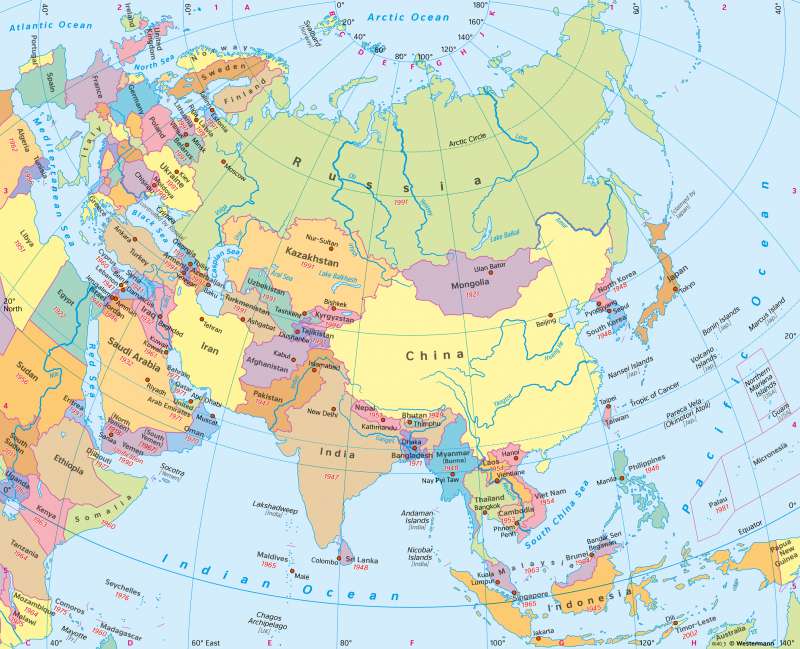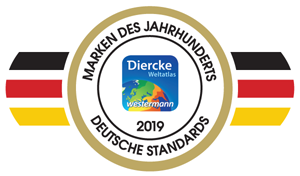Asia - Political map
Geopolitics
978-3-14-100890-6 | Page 118 | Ill. 1

Overview
Many Asian states received their current borders when they were granted independence by the colonial powers after the Second World War, others proclaimed their state sovereignty after the disintegration of the world power Soviet Union.
Independence and recent history of Asian countries
India and Pakistan had belonged to the British colonial empire (British India) since 1818. In 1947, they were divided into Islamic Pakistan and predominantly Hindu India. East Pakistan, part of Pakistan since 1947 due to its Muslim majority, became independent in 1971 as the People's Republic of Bangladesh. Border disputes between India and Pakistan over the Kashmir region, which is predominantly Muslim but nevertheless belongs to India, led to a permanent conflict that could not be settled even by the partition of Kashmir in 1966. The former Ceylon, from 1505 in the possession of the Portuguese, then the Dutch, finally the British, was granted independence in 1948 and became a republic under the name Sri Lanka in 1972. The long-standing civil war-like conflicts between Tamils and Sinhalese were only settled in 2009. Myanmar (Burma), Indonesia, Vietnam, and the Philippines, which were occupied by Japan during the Second World War, were also granted autonomous status after the Second World War. Myanmar had fallen to British India in 1886 and to Japan in 1942 before gaining independence in 1948. After decades under a military dictatorship, the country has had a constitution and a civilian head of state since 2011.
In Korea, Indonesia, and Vietnam wars against the political division of the world escalated due to the intervention of foreign powers. The first of these proxy wars occurred in Korea. The country, a Japanese protectorate since 1905 and a Japanese colony since 1910, was granted independence in 1948, but was de facto occupied by the Soviet Union in the north and the USA in the south. In 1950, the Korean War began, which led to the country's split in 1951 into the People's Republic of North Korea, which is still ruled autocratically, and the Western-oriented Republic of South Korea.
In the French colony of Indochina, rebels under Ho Chi-Minh proclaimed the Republic of Vietnam in 1945. After long battles between the Chinese-backed Viet Minh and France, Indochina was divided into the sovereign states of Laos, Cambodia, and North and South Vietnam in 1954. However, the simmering conflict between the communist North and the pro-Western South of Vietnam continued and culminated in the Vietnam War in 1957, in which the USA intervened militarily. After devastating fighting, countless civilian casualties and the withdrawal of US troops, the divided country was reunified as the "Socialist Republic of Vietnam" in 1976. Vietnam has had a constitution since 1992 and has been a member of ASEAN since 1995.
Cambodia and Laos were also involved in the war. Cambodia became involved in the Vietnam War through a military coup. From 1970 to 1975, the country suffered under the reign of terror of the dictator Pol Pot and his Khmer Rouge. Since 1993, Cambodia has been a constitutional monarchy. Laos was occupied by South Vietnam in 1973 and ruled by a communist leadership under Vietnamese influence from 1975. The Lao People's Republic has had a constitution since 1991.
In China, the government was overthrown in 1949 after many years of guerrilla warfare. Chiang Kai-shek had to flee with his approximately two million followers to the island of Taiwan, where he proclaimed the National Republic of China in 1950, which is not recognised as a sovereign state by most member states of the United Nations.
Meanwhile, in the Socialist People's Republic of China under Mao Tse-tung, there was a nationalisation of industry, trade and agricultural production and a ruthless fight against perceived political opponents ("Cultural Revolution"). After Mao's death in 1976, China pursued a moderate socialist course. Since the country opened up more to foreign trade in the early 1990s, it has experienced an enormous economic boom.
Mongolia had seceded from China in 1911 and declared independence but was still occupied and fought over afterwards. It was not until 1924 that the state was finally founded as a socialist Mongolian People's Republic.
The most significant political event in the recent past was the disintegration of the Soviet Union, which once again changed the world of Asian states. On 26 December 1991, the Soviet Union was formally declared dissolved. In addition to Russia, the largest country in the world by area, the successor states of Kazakhstan, Uzbekistan, Turkmenistan, Tajikistan, Kyrgyzstan, Georgia, Armenia, Azerbaijan, Ukraine, Belarus, Moldova, Estonia, Latvia, and Lithuania emerged on its territory. The region of Nagorno-Karabakh (between Armenia and Azerbaijan) as well as South Ossetia and Abkhazia (parts of Georgia under international law) have also declared themselves independent, but they are not recognised internationally. The most recent conflict hotspots in this region are Crimea, Ukrainian territory that has been under Russian administration since 2014, and eastern Ukraine.
Saudi Arabia has been independent since the proclamation of the Kingdom in 1932. Iraq, a British mandated territory since 1921, gained full sovereignty in 1955. Kuwait, Bahrain, Qatar, the United Arab Emirates (UAE), the Sultanate of Oman, and Yemen were British protectorates or close allies of Britain in the 19th century. They achieved national independence in the course of the 20th century.
Current trouble spots with armed conflicts, political instability and resulting high numbers of refugees are Syria, Iraq, and Afghanistan.




